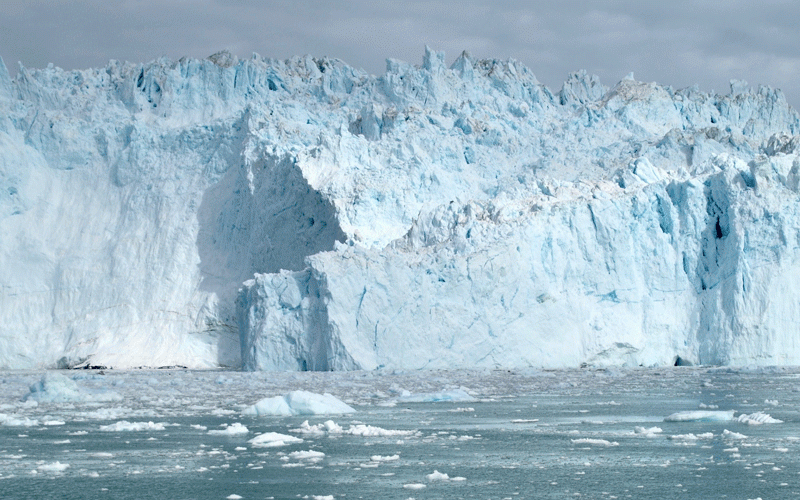
I’m writing this on a plane to Greenland — well, actually, on a plane to Denmark, because there’s no way to get to Greenland by a civilian airline without going through Copenhagen first — and it has occurred to me (not for the first time) to wonder where everybody else is.
My wife and I are on our way to shoot a documentary film about a handful of scientists who have an idea to slow the speed at which glaciers are sliding into the sea. If it works, it would drastically lower the predicted level of sea level rise.
As the warming proceeds and the world’s remaining ice melts, sea level rise is going to become a grave problem for every country with a coastline, so you’d think there would be legions of people working it. There are not.Worldwide there may be a thousand scientists working on the ‘cryosphere’, the frozen parts of the planet, but their energies are divided among many different aspects of climate change: thawing permafrost releasing megatonnes of methane; loss of sea ice cover on the Arctic Ocean, why the Arctic is warming four times faster than the rest of the planet, etc.
How many people are working specifically on accelerating glacial flows? Maybe a hundred full-time scientists, if you’re feeling optimistic.
What holds glaciers back is the friction between the ice and the bottom. Warmer ocean currents are eating away at the base of the glaciers and effectively detaching them from the bottom, i.e. taking the brakes off.
The official Intergovernmental Panel on Climate Change forecasts no more than one metre of sea level rise by 2100. Many scientists think two metres is more likely, given predictable further warming even with rapid cuts to emissions. And if the entire, quite unstable West Antarctic Ice Sheet starts to slide into the sea, four metres by 2100.
A two-metre sea level rise would flood land that is home to a quarter-billion people: in Asia, goodbye to Shanghai, Bangkok and Calcutta; in the US, farewell to Miami and New Orleans. At four metres, at least a billion people would be looking for new homes — and they wouldn’t be in the mood to take no for an answer.
So this plane, and lots of others heading to the polar regions, should be full of climate scientists looking for ways to slow down the glaciers and the consequent sea level rise. We’re already locked into far too much warming, and just cutting emissions is not enough.
- World View: Where is everybody? The human speed limit
- Climate change impact on eye health in Zim
Keep Reading
However, there are just five scientists and engineers on this trip: an American, two Canadians, a Brit (who’s normally based at a Chinese university) and a Finn. They have a really promising idea for slowing down the glaciers and reducing the speed of sea level rise, but there should be ten or thirty or fifty teams working on promising ideas.
I’ll get into what their specific idea is next week, after everybody has a better feel for how the proposal will be met, but my point right now is how pathetically few they are. Not only that, but they are all self-financing (although some of their universities are helping with the travel). This is hardly an adequate response to the threat.
Consider, for a moment, the ‘Manhattan Project’, which employed 130,000 people in 1942-45 to build the first atomic bombs. It cost about $23 billion in today’s money, but nobody objected because they were afraid that the Germans might get The Bomb first. (In fact, the Germans weren’t even trying.)
Global warming is at least as big a threat as a few first-generation nuclear weapons in in Nazi hands — far bigger, I’d say — so why is the response so muted? Can’t people see that climate change is an existential threat that would justify dozens of Manhattan-scale crash projects to curb the warming?
No, they can’t, and I suspect our ancestors are to blame. All our ancestors were hunter-gatherers for at least 98% of human history, and hunter-gatherers lived in the short term.
They could react very fast to immediate and visible threats, but they could do nothing about longer-term challenges like changes in the climate or in animal migration routes, so they didn’t waste time worrying about them. We are their descendants, and that’s our default mode too.
What I’m suggesting, I’m afraid, is that there may be a sort of species-specific speed limit on how fast human societies can respond even to very big threats if they are slow-moving, impersonal and invisible. The Manhattan Project people were in the middle of a war against human enemies; we are not.If there is such a speed limit, does that mean we are doomed? Who knows? How fast is fast enough? But the graduate schools are now full of people studying climate science, and despair is not a useful option.
- Dyer is a London-based independent journalist. His new book is titled The Shortest History of War.











